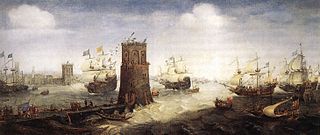
The Kingdom of Jerusalem, also known as the Latin Kingdom, was a Crusader state that was established in the Levant immediately after the First Crusade. It lasted for almost two hundred years, from the accession of Godfrey of Bouillon in 1099 until the fall of Acre in 1291. Its history is divided into two periods with a brief interruption in its existence, beginning with its collapse after the siege of Jerusalem in 1187 and its restoration after the Third Crusade in 1192.

Year 1221 (MCCXXI) was a common year starting on Friday of the Julian calendar.

Year 1218 (MCCXVIII) was a common year starting on Monday of the Julian calendar.

Year 1249 (MCCXLIX) was a common year starting on Friday of the Julian calendar.

The Fifth Crusade (1217–1221) was a campaign in a series of Crusades by Western Europeans to reacquire Jerusalem and the rest of the Holy Land by first conquering Egypt, ruled by the powerful Ayyubid sultanate, led by al-Adil, brother of Saladin.

The Seventh Crusade (1248–1254) was the first of the two Crusades led by Louis IX of France. Also known as the Crusade of Louis IX to the Holy Land, it aimed to reclaim the Holy Land by attacking Egypt, the main seat of Muslim power in the Near East. The Crusade was conducted in response to setbacks in the Kingdom of Jerusalem, beginning with the loss of the Holy City in 1244, and was preached by Innocent IV in conjunction with a crusade against emperor Frederick II, Baltic rebellions and Mongol incursions. After initial success, the crusade ended in defeat, with most of the army – including the king – captured by the Muslims.

Damietta is a port city and the capital of the Damietta Governorate in Egypt. It is located at the Damietta branch, an eastern distributary of the Nile Delta, 15 kilometres (9.3 mi) from the Mediterranean Sea, and about 200 kilometres (120 mi) north of Cairo. It was a Catholic bishopric and is a multiple titular see. It is also a member of the UNESCO Global Network of Learning Cities.

Al-Kamil was a Kurdish Muslim ruler and the fourth Ayyubid sultan of Egypt. During his tenure as sultan, the Ayyubids defeated the Fifth Crusade. He was known to the Frankish crusaders as Meledin, a name by which he is still referred to in some older western sources. As a result of the Sixth Crusade, he ceded West Jerusalem to the Christians and is known to have met with Saint Francis.
Al-Malik as-Salih Najm al-Din Ayyub, nickname: Abu al-Futuh, also known as al-Malik al-Salih, was the Ayyubid ruler of Egypt from 1240 to 1249.
John of Ibelin, count of Jaffa and Ascalon, was a noted jurist and the author of the longest legal treatise from the Kingdom of Jerusalem. He was the son of Philip of Ibelin, bailli of the Kingdom of Cyprus, and Alice of Montbéliard, and was the nephew of John of Ibelin, the "Old Lord of Beirut". To distinguish him from his uncle and other members of the Ibelin family named John, he is sometimes called John of Jaffa.

Guillaume de Sonnac was Grand Master of the Knights Templar from 1247 to 1250.
The Battle of Fariskur was the last major battle of the Seventh Crusade. The battle was fought on 6 April 1250, between the Crusaders led by King Louis IX of France and Egyptian forces led by Turanshah of the Ayyubid dynasty.

The siege of Damietta of 1218–1219 was part of the Fifth Crusade in which the Crusaders attacked the Egyptian port city of Damietta. The city, under the control of the Ayyubid sultan al-Kamil, was besieged in 1218 and taken by the Crusaders in 1219.

The Crusades were a series of religious wars initiated, supported, and sometimes directed by the Christian Latin Church in the medieval period. The best known of these military expeditions are those to the Holy Land in the period between 1095 and 1291 that were intended to reconquer Jerusalem and its surrounding area from Muslim rule. Beginning with the First Crusade, which resulted in the conquest of Jerusalem in 1099, dozens of military campaigns were organised, providing a focal point of European history for centuries. Crusading declined rapidly after the 15th century.

The Battle of Mansurah was fought from 8 to 11 February 1250, between Crusaders led by Louis IX, King of France, and Ayyubid forces led by Sultana Shajar al-Durr, vizier Fakhr ad-Din ibn as-Shaikh, Faris ad-Din Aktai and Baibars al-Bunduqdari. It was fought in present-day Mansoura, Egypt. The Crusader force was enticed into entering the town where it was set upon by the Muslim force. The Crusaders withdrew in disorder to their encampment where they were besieged by the Muslims. The Crusaders broke-out and withdrew to Damietta in early April.

A series of Crusader invasions of Egypt were undertaken by the Kingdom of Jerusalem from 1163 to 1169 to strengthen its position in the Levant by taking advantage of the weakness of the Fatimid Caliphate.

John Tristan was a French prince of the Capetian dynasty. He was jure uxoris count of Nevers from 1265 and of Auxerre and Tonnerre from 1268. He was also in his own right Count of Valois and Crépy, as an appanages of the crown, from 1268.
Fakhr al-Din ibn al-Shaykh was an Egyptian emir of the Ayyubid dynasty. He served as a diplomat for sultan al-Kamil from 1226 to 1228 in his negotiations with the Holy Roman Emperor Frederick II leading to the end of the Sixth Crusade. He later commanded forces during the Seventh Crusade, dying at the Battle of al-Mansura in 1250.
The battle of Mansurah took place from 26–28 August 1221 near the Egyptian city of Mansurah and was the final battle in the Fifth Crusade (1217–1221). It pitted the Crusader forces under papal legate Pelagius Galvani and John of Brienne, king of Jerusalem, against the Ayyubid forces of the sultan al-Kamil. The result was a decisive victory for the Egyptians and forced the surrender of the Crusaders and their departure from Egypt.
The battle of Fāriskūr was a pitched battle fought between the army of the Fifth Crusade and Ayyubid Egypt on 29 August 1219 outside the Ayyubid encampment at Fāriskūr. It was fought while the siege of Damietta was ongoing. An Ayyubid victory, it had little effect on the course of the war.












